| Galana River II
Tips and Improvements |
Eberspacher heater
Installed Easter 2005, makes for a pleasant winter use of the boat. It was installed in the port rear electrical locker and the piping was circulated anticlockwise looking forward. It was quite a hassle, but we finally made it. Jeanneau should put these pipes in as standard practice when they build the boat, as the cost and effort is minimal during construction.
The two back lockers are vital for access
Solar Panels
Two panels were mounted on the coach-roof, with a clean invisible wiring and a control panel in the
TV flatscreen - great company when idle in port. Antenna on masthead.
Mast steps
Folding steps have been applied to the mast in order to climb up to the first spreaders.
Protection of navigation instrument switches
In
two alarming occasions I had the boat suddenly veer sharply to port, as
the auto-pilot was inadvertently switched off, when somebody dragged out
the binoculars from the well-locker at the base of the control panel. When
I finally understood the cause, the remedy was to place a protection cover
over the row of the instrument switches.
Inner
forestay
With
a storm jib up and the mainsail well-reduced, the boat becomes very stable,
even in 40 knot winds and both the helm and wife become docile.
I
consider the inner forestay a most important addition to the boat’s
sail-plan and allows you to face critical situations in tranquillity and
safety (the storm-jib is my wife’s most favourite sail).
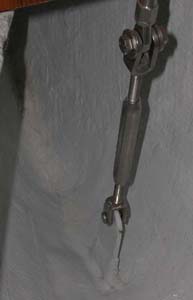
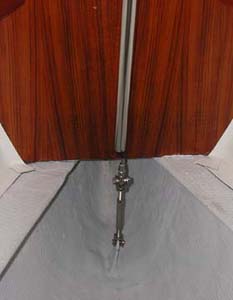
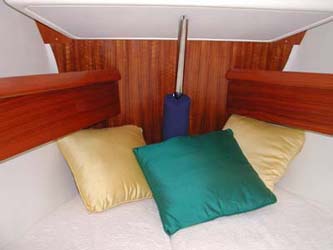
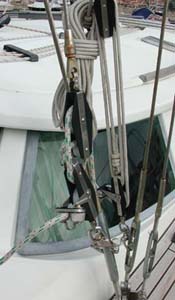
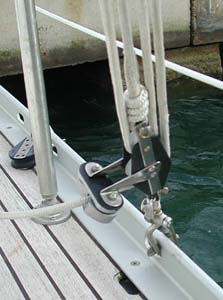
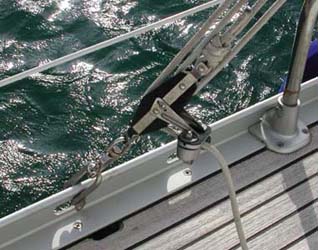
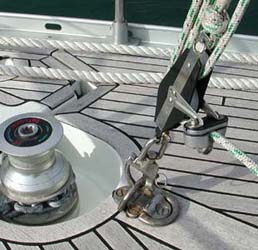
The
stay passes through the forward cabin and is solidly anchored to the keel
in a bed of fibreglass. I have installed two flying back-stays to counter
the pull of the storm-jib. These are hooked into position, only when
needed.
Roller reefing Storm Trysail
The roller furler for the storm jib, operated from the cockpit.
As the wind can increase to 30 knots within minutes in the Mediterranean, I have decided to keep a storm trysail ready to be unfurled at a moments notice, especially when cruising with my wife.
Inverter
A
1500 watt inverter is a convenient and silent way to produce 220 volts
electrical current, for charging mobile phones, using computer and
printer, vacuum cleaner and ladies hair-dryer.
It
was placed in the locker under a nav table chair, which is also my
tool-cabinet. Two extra batteries were placed under the floor-boards in
front of the main heads.
Holding tank for main heads and shower - installed in the shower locker. A first one was made in stainless steel, but it leaked! So I had it remade in plastic. I added piping from the main shower, so that in the marina, you can soap up without worrying about draining into the sea.
Shower 3-way valve
Main 3-way valve
Fore water tank - as there was a faulty tank never claimed on the warranty, I had to replace it. But the original was installed during construction, so there was only way to remove it, in pieces! The new one had to be smaller, only 100 litres, leaving some extra storage space.
Warp locker - when substituting the motor exhaust hose, I noted an unused locker space, which I utilised for a 40 metre warp, which can be quickly unfurled for a stern anchor or for a shore line. A hole was drilled into the side panel and the line simply dropped into a plastic tray attached to the floor. When not in use a cap is screwed on.
Anti-slide
stops
On
the navigation table I mounted a wooden rod to increase the holding
capacity of the low existing inner edge.
Similar ones were also put into the bathroom cabinets.
Three
chrome stops (drawer handles) were fixed to the kitchen work-bench in
strategic points, to prevent cups and trays from sliding around in rough
seas.
Bilge-lockers
When
you poke around the bilges, you will find lots of empty spaces that can
easily be used for storing goods. The only problem is finding
appropriately sized plastic containers, which is not easy, as the required
shapes are odd and vary considerably. It is a pity that Jeanneau does not
supply them.
Bicycle storage - In bilge compartment
Fan and courtesy reading light
A removable fan was installed and an extra reading light in a comfortable position in the
Locker
inventories
It
may seem excessive, but I find that a written inventory of the contents of
the main lockers very useful for keeping tabs on equipment. It saves you
rummaging around in an emergency.
Motor bilge-pump
A two-way valve was installed at the engine sea-cock, to e able to close off sea water intake in case of a boat-threatening leak and use the motor to powerfully suck in and expel the water from the bilges.
Hand rail on gang-plank
Two attachments were soldered onto the gangplank to take two stanchions for a hand rail, to make it easier for the ladies.
Electrical winch
This is a boon to the short-handed and/or middle-aged sailor, as it makes things much easier in those critical moments when you are tired and in a hurry. It has one short-back, it does not tell you when it is straining the sheet and it just goes on pulling, when it shouldn't be and rips things out.
So the tip is to never hook the sheet in the self-tailer, but hold it in your hand and watch what you are doing. Firstly, you get a better feel of any strain and if you haven't put too many winds, the sheet will slip if there is a strong resistance. Secondly, a thin sheet, may twist back and re-wind itself into the winch and the winch will keep on winding and tighten everything up, so that the only way out is to cut the sheet.
If you ever do have to cut a very taught sheet, tie a line onto it first, as it will whip out of its slot and go up the mast, being quite impossible to retrieve in a rolling sea.
Mistake
1
My two mistakes were firstly to try and reef that very last bit of
main-sail, which should stay out of the mast. On this occasion I broke a
block on my very first outing. A coloured tape on the mast could serve as
a marker to show the point beyond which the sail should not go.
Mistake
2
The second mistake, was furling the genoa in 40 knot winds, before
entering the marina. Perhaps I was not heading perfectly to windward, so
there was strain on the genoa and it wound up very tightly. This means
that you run out of sheet length, because it takes more turns to wind up
the genoa, so that you keep on winching and pull the furling drum apart.
As I said, the electrical winch does not tell you it is straining the
equipment. I now always keep an eye on that last metre of genoa sheet, to
make sure there is still some left on the drum.
When reefing or furling the in-mast mainsail, I have a glove on my left hand and hold the main sheet and the unfurling sheet in the one hand and keep them both taught, while the winch winds. The unfurling sheet slowly slips through my hand, while the main sheet is held tight. This means that after each metre I have to change position of my hand on the main sheet closer to the winch, but the sail is wound tight around the mast and it is done fairly quickly and alone.
If
the mainsail is not wound compact, it will be too bulky to furl in, or may
stick and not be easily unfurled later.
So attention must be paid in this manoeuver. With these simple precautions,
there should be no trouble with furling sails, unless there is something I
haven't encountered yet. If you know of anything else I should be aware
of, please do let me know.
NEXT>>> Photo Gallery
A Mediterranean Cruising
Sail Boat
Copyright L. Camillo Sept. 2006